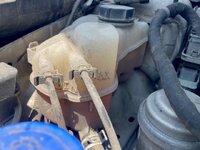2015 Ford Fusion, 1.5L Engine
Vehicle has 115k miles. Getting ready to do a coolant flush and change using motorcraft products. I found a coolant flush and change procedure online. Please see video link below. I have a question about getting the correct mix/ratio when I go to do the refill. The person in the video correctly points out that parts of the cooling system, specifically the cylinder block still have water in it, and to equal this out, he does a fill of about 60-70% coolant and 30-40% distilled water which would get him to a final ratio of 50/50 once everything is mixed. My question is how much water is still in the cooling system? Should I do 60/40 or 70/30 when I go to do the refill (to get the final mix of 50/50). It just seems like being off by 10% could be a lot. Any help would be appreciated, thanks.
How To Perform A Coolant Flush On Your Ford Vehicle
Vehicle has 115k miles. Getting ready to do a coolant flush and change using motorcraft products. I found a coolant flush and change procedure online. Please see video link below. I have a question about getting the correct mix/ratio when I go to do the refill. The person in the video correctly points out that parts of the cooling system, specifically the cylinder block still have water in it, and to equal this out, he does a fill of about 60-70% coolant and 30-40% distilled water which would get him to a final ratio of 50/50 once everything is mixed. My question is how much water is still in the cooling system? Should I do 60/40 or 70/30 when I go to do the refill (to get the final mix of 50/50). It just seems like being off by 10% could be a lot. Any help would be appreciated, thanks.
How To Perform A Coolant Flush On Your Ford Vehicle

